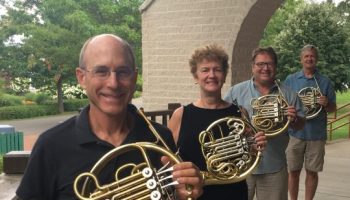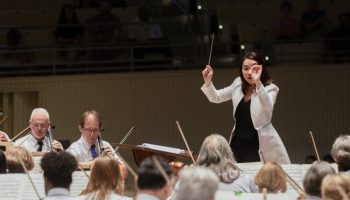
No horns, no harps — just beauty. With strings alone, Vahn Armstrong and Eva Stern are bringing the contrasting styles of Mozart and Martinů to this week’s “Into the Music” with the Chautauqua Symphony Orchestra.
Armstrong, violinist and the CSO’s associate concertmaster, will be joined by Stern, his partner and long-time member of the CSO’s viola section, at 8:15 p.m. EDT Tuesday, July 14, on the Virtual Porch.
The duo will play three movements of two pieces: Mozart’s “Duo for Violin and Viola” in G major, K. 423 and Bohuslav Martinů’s “Three Madrigals,” also arranged for violin and viola.
“Even with no horns, harps or trumpets, both pieces are remarkable in the range of color and texture they achieve,” Stern said. “We love playing them both simply because they’re beautiful.”
Beautiful, but in their own way.
“They contrast one another significantly,” Armstrong said. “When you put them on a program together, you give the listener the best of both worlds.”
Mozart’s “Duo for Violin and Viola” in G major, K. 423, is the first of the two he wrote in the summer of 1783 to complete Michael Haydn’s set of six for the Archbishop Colloredo. Haydn couldn’t finish them because he was sick, so Mozart wrote the pieces and released them under Haydn’s name.
Armstrong considers it a “standard” in a violin and viola duo’s repertoire.
“We have been talking for years about finally doing this Mozart piece,” he said. “Apparently, it does take a pandemic to do it.”
Haydn’s duos typically gave the violin a more soloistic lead, adding viola accompaniment through multiple double stops, or two separate strings bowed or plucked simultaneously. Mozart’s duos differ in that the viola has many of its own passages in sixteenths, almost in equal proportion to the violin.
There is a saying about Mozart, that it is too easy for children and too hard for grown-ups,” Armstrong said. “There is a kind of simplicity, which doesn’t give young students a chance to flex their technical muscles. But to actually play it like it’s supposed to be played — it’s perfection. Perfection is never easy.”
The violin starts the piece with a descending scale leading to grace notes, musical “ornaments” not essential to the melody, Armstrong said. For the remainder of the piece, as each instrument takes a breath, the other comes in with a more thematic tone, mimicking a game of “cat and mouse.”
“There is a saying about Mozart, that it is too easy for children and too hard for grown-ups,” Armstrong said. “There is a kind of simplicity, which doesn’t give young students a chance to flex their technical muscles. But to actually play it like it’s supposed to be played — it’s perfection. Perfection is never easy.”
The “Three Madrigals” for violin and viola were completed in New York in July 1947 and dedicated to the violist Lillian Fuchs and her brother, Joseph. Stern said the sound gives off a “20th-century feel” in its syncopated rhythms and harsher dissonance.
“There are so many moments that sound like more than two instruments,” Stern said. “The second movement stands out because it has these chorale-sounding parts that make it seem like, all of a sudden, the sound has blossomed into being more than just the two of us.”
Martinů drew from Bohemian and Moravian folk themes and dances to create rhythms representative of madrigals, vocal chamber music that originated in northern Italy during the 14th century. Stern said the tone contains hints of the Renaissance and Baroque eras.
“There is so much energy that it feels satirical in a sense,” Stern said, adding that their responsibility is to do “as best as we can.”
“Our best is the musical equivalent of getting into different characters as an actor,” Stern said. “The two pieces are such different characters, but both are full of imagination and surprising colors and, I think, some really exalted moments of beauty.”




